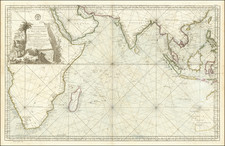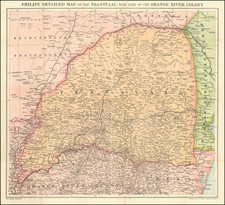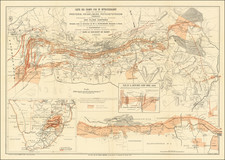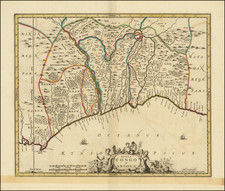Very rare - the earliest issue of James Wyld's important South Africa map sequence, issued in 1843. Unknown to Norwich!
This important and fascinating map shows South Africa as it appeared in 1843, during the period of the Great Trek and the British expansion onto the Eastern Cape and Natal. The map shows much of western and southern South Africa divided up into districts under British administration, each attractively distinguished by their own color. At the time, British hegemony extended as far east as the area around New East London, and up to the Sandy River, while Colesburg was the furthest point inland. Additionally, the map features the brand new British Colony of Natal (proclaimed May 4, 1843), which had recently been annexed from the Afrikaners but which had not yet been divided into districts. The regions in the interior, beyond the British districts, were then being contested by the Afrikaners and the indigenous peoples, although innumerable Afrikaan's settlements and placemanes are labelled.
Great Britain had acquired the Cape of Good Hope Colony from the Netherlands in 1806. During the early days of the new regime most of the European settlement was confined to the Eastern Cape, while the land beyond was still largely in the possession of the indigneous peoples. By 1824, however, the established Afrikaner population of the Cape chafed under British rule and from that time many embraked on the Great Trek towards the east and into the interior to create new republics, beyond the authority of the British. The first such republic was Natalia, founded in 1838, in modern day KwaZulu-Natal. While 'Voortrekkers' had arrived in the area in the 1820s, it took some time for the Orange Free State (1854) and the Transvaal (1856) to be incorporated.
The present map was made during a very uneasy time, when the British regime sought to contain the Afrikaners' ambitions (but without provoking them to mount open violent resistance), while gradually expanding its control of terriory eastwards at the expense of the indigenous Xhosa and Zulu peoples. The most recent major advance was the The Sixth Frontier War ("Hintsa's War") of 1835, where forces under the British Governor Sir Benjamin d'Urban annexed portions of the coastal Eastern Cape beyond New East London from the Xhosa. While the British managed to gain control of Natal by 1842, for the next several years they would refrain from venturing deeper into the northeastern interior of South Africa, as they rightly feared the great military prowess of both the Afrikaners and the Zulus. Only with the discovery of vast quantities of gold and diamonds in the interior in the 1860s, would the British commence their ardent attempts to control all of South Africa.
The present map is highly important, as it appears to be the earleist issue of the Wyld map sequence of South Africa, which was by far the most important and influential series of maps to show South Africa's political evolution during the 19th Century. This first edition was issued in 1843 (shortly after the creation of the Colony of Natal), while subsequent editions were produced regularly by the Wyld firm up to 1889.
There are several differences which can immediatey distinguish between the present example of the map and the 1844 edition, as illustrated by Norwich (Map 198):
- The 1843 edition shows a massive area labled simply "Natal". The 1844 edition adds the regions of Durban, Upper Umzinyati, Impafana, Umvoti, and PIet Maritzburg in Natal.
- The 1843 edition does not include the Umzinkulwana River, Umpedsee River and Cane Vill in Northern Coastal Cafria.
- The 1843 edition shows New Hantam only. The 1844 edition adds "Albert" to the west.
- The 1844 edition adds two regions to the east of Albany (Victoria and British Kaffrara).
- In several of the regions noted above, there is significantly more detail, including roads, towns, rivers, etc.
James Wyld (1812-1887), was the Royal Geographer to Queen Victoria and Prince Albert (the prince maintained a great interest in science and cartography) and the official heir to the legendary mapmaker William Faden (1749-1836). Wyld had extraordinary access to the map archives of the British Colonial office and this allowed him to regularly produce the most up-tp-date and accurate maps of key regions of the British Empire, including South Africa, New Zealand, Australia and Canada. Wyld's maps, such as the present map of South Africa, were considered to be the authoritative colonial maps and were consulted by the Cabinet at Whitehall and colonial officals in places such as Cape Town.
The present map is very rare. We cannot find any record whatsoever of this early issue, which predates the 1844 edition, which was otherwise thought to be the earlist issue of the Wyld South Africa sequence. The Norwich collection at Stanford University illustrates the four known examples, but does not show this early state.
Given the significance of the Wyld sequence, this first issue is therefore of great import to the cartographic history of South Africa.
James Wyld Sr. (1790-1836) was a British cartographer and one of Europe’s leading mapmakers. He made many contributions to cartography, including the introduction of lithography into map printing in 1812.
William Faden, another celebrated cartographer, passed down his mapmaking business to Wyld in 1823. The quality and quantity of Faden’s maps, combined with Wyld’s considerable skill, brought Wyld great prestige.
Wyld was named geographer to Kings George IV and William IV, as well as HRH the Duke of York. In 1825, he was elected an Associate of the Institution of Civil Engineers. He was one of the founding members of the Royal Geographical Society in 1830. Also in 1830, his son, James Wyld Jr., took over his publishing house. Wyld Sr. died of overwork on October 14, 1836.
James Wyld Jr. (1812-87) was a renowned cartographer in his own right and he successfully carried on his father’s business. He gained the title of Geographer to the Queen and H.R.H. Prince Albert. Punch (1850) described him in humorous cartographic terms, “If Mr. Wyld’s brain should be ever discovered (we will be bound he has a Map of it inside his hat), we should like to have a peep at it, for we have a suspicion that the two hemispheres must be printed, varnished, and glazed, exactly like a pair of globes.”









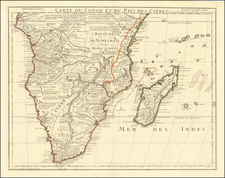
![[South Africa / Namibia / Angola] Coste Occidentale D'Afrique Depuis le XIe. Degre De Latitude Meridional, Jusqua'au Cap de Bonne Esperance Tiree de la Carte de l'Ocean Meridional . . . 1739](https://storage.googleapis.com/raremaps/img/small/77033.jpg)
